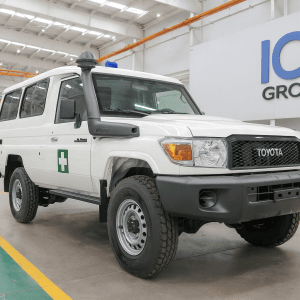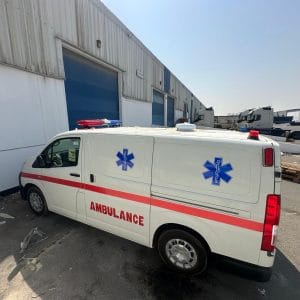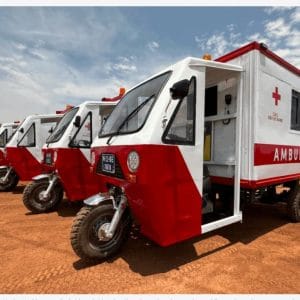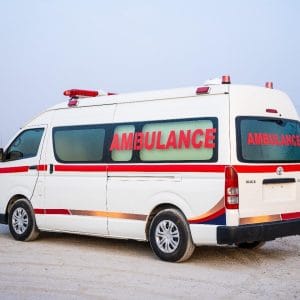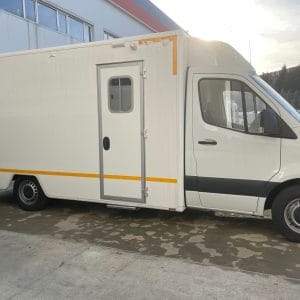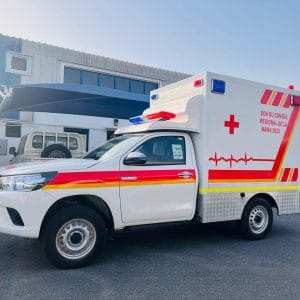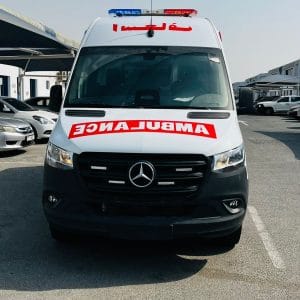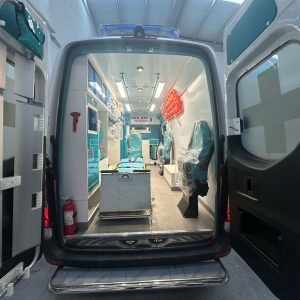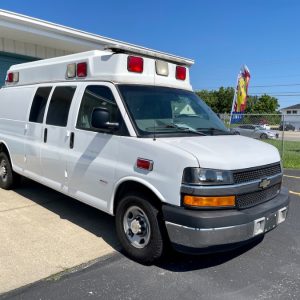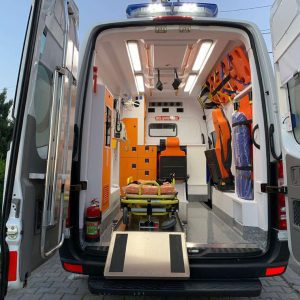1. Introduction to Mobile Command and Control Vehicles
The establishment of Mobile Command and Control Vehicles (CCVs) is a beneficial solution to any of the current difficulties we are faced within the operations of the law enforcement organizations and could be applied in a multitude of operational situations pertaining to the law enforcement bodies in a variety of countries. Today, with the benefits of modern communication technologies and equipment, these CCVs are complete headquarters converging all the managerial, control, and operational facilities, much similar to the classical fixed headquarters. Future military operations will require command and control to be exercised at the highest tactical level possible, taking all secure communication links into account, and under the extended range of non-linear missions; the use of Mobile Command and Control Vehicles provided the opportunity for a dynamic and flexible management of these functions in the respective area of activities. And the mutual understanding between the dedicated and specialized task forces co-located in other strategic structures is far from being attainable under such high requirements and responsibilities. These vehicles provide mobile command and control capabilities from a visually non-descript vehicle, van, or motor home.
2. Historical Development and Evolution
The idea of developing a vehicle that could provide centralized communication management from any location originally came from the need in the American military to be able to support the rapid redeployment of air assets from airfield facilities that had been heavily damaged or destroyed by enemy action. The fastest way to achieve this rapid redeployment was to ensure that the air assets were able to take off and be supported from a minimum number of key airfields. But air operations cannot be supported without communications, and central command and control facilities could not be relocated in a manner that would enable them to maintain an uninterrupted air control capability.
A cost-effective and operationally acceptable solution to this problem was to develop and deliver an air transportable mobile command and control center so that essential communications could be maintained from an interim location while airfield facilities mission essential for air operations were put back into operation. Because of the diversity of the military equipment and the nature of the military organization responsible for its operation and support, it was not unusual to see a number of variations of this capability fielded by commands and organizations at different organizational levels. The end of the Cold War and the increasing cost of maintaining the large Cold War force structures led to a dramatic decrease in military budgets as well as reductions in the assets of various services.
3. Key Components and Technologies
The mobile command and control vehicle (MCCV) consists of many systems. These range from the main vehicle structure to the most comprehensive C4ISR systems. Since the MCCV may be unique in its design and embodiment, anything concerning it may or may not be placed in the borders of the MCCV literature. But, for obtaining a complete understanding of the MCCV technology, CNN kindly defines and groups the key MCCV elements. According to CNN, key MCCV elements may be given either separately or combined in a list and in a group manner. The mission of the MCCV represents what and how many systems are being accommodated. The MCCV concept and application approach represents the level of technology in the MCCV. While the vehicle structure, office facilities, onboard products, and the onboard systems do represent the MCCV accessories, prime power units, major environmental, conventional features, CCP, select accessories, vehicle application, NBC features, etc., represent the vehicle accessory keys not given as forms of lists.
But, by taking into account the vehicle and the mission requirements; two or three different MCCV types, an inventory of structure or hard to change segments (floor, ramp interiors, etc.), an inventory of electrical and communications or easy to change segments (interior straps, power connectors, etc.), room introspection package, optional modules and panels, some embodiment details, special cases, the mission network design, the technical segments of the mission-C3I/com coal standards, and a rough estimate of how many people, what buildings, equipment will be needed, the MCCV designing hull line, cabin and equipment architecture, accessory and spares typical list may form the MCCV related terms.
3.1. Communication Systems
Communication systems are likely to be the most important component of an MCV. High performance command and control requires a good communication infrastructure. Messages have to be exchanged over the entire operational area and between all different levels of the mission. The different actors rely on various communication devices: radios, telephones, satellite communication.
MCVs provide both voice and data communications to personnel, other ground assets, aircraft, and the rear echelon. They are equipped to receive both secure and non-secure voice and data communication, and they can be enlarged to serve as a telecommunications facility. Today, multi-band radios, able to transmit and receive on various channels as well as to connect different types of frequencies (VHF/UHF links, for example), provide the best voice communication capabilities. In addition, the MCV is connected to the higher echelon headquarters and to other MCVs deployed in the operation.
Depending on the operational area (urban versus rural areas, the presence of obstacles: mountains, forests, buildings, sparsely inhabited spaces) that can affect the range of the communication equipment, an MCV must be equipped with extensive inside communications. When the mission requires coverage of remotely located communication units, which are outside the range of the MCV communications, these external units may be linked via relays. The relays, sited at favorable locations, receive the message from the external unit to be connected with the MCV, and then retransmit it to the MCV.
In this work, the possibility of using communication relays is more deeply investigated according to the mission, and the capability of the MCV to move to an alternative location to improve its external communication range is analyzed. The coverage of such a high number of communication technologies must be realized and guaranteed, with dedicated systems or commercial devices. The antennas and the related devices (frequencies, interface), when placed on the vehicle, must be ergonomically designed, respecting the strict layout defined by the action-environment constraints. Besides, the maintenance of the antennas and the systems must be easy to carry out.
3.2. Data Processing and Analysis Tools
The parallel evolution of the vehicle-based mission systems with the more transportable operations centers has helped to accelerate the deployment of these available capabilities in the forward area of the battle. The basic equipment load carried in these or similar mobile command and control vehicles, which was determined based on the results of an extensive analysis and is considered to be representative, includes environmental control, operator work stations, visual displays for voice switches, radio terminals, various accessories, and an automatic data processing and display system. The vehicle-mounted data processing equipment may be seen as performing three general types of data processing functions when used for the command and control mission.
The first function is editorial with text editing, file transfer, and file backup or restore capability required by the staff planners. The second function is the numerical processing conducted by the system software that has been made available to support the specialty system software applications that require numerical output and operate in a timesharing environment for efficient use of the shared data processing resources. The system software environment includes a timesharing operating system, data management software used as an intermediate data base and shared power supply, common service facilities for communications support, and numerous tools and utilities. This category also covers the design of user-friendly interfaces and document readers that facilitate management and editing activities. These interfaces allow easy and efficient means for job transfer, file backup, display formatting, report editing, data requirement and division preparation, and updating of data utilizing plotter-generated overlays.
3.3. Surveillance and Reconnaissance Equipment
Surveillance and reconnaissance (SR) is an important part of crisis management, especially in the early phases of response. Modern technology in data and video transmission and processing enhances mobile command support given through mobile command vehicles by the use of remote-controlled surveillance and reconnaissance equipment. The decision-maker benefits from being able to handle data when participating in the operation or doing his duties in his office. The decision-maker can also get a realistic picture of the circumstances when installed video equipment gets data produced from, for example, an observation helicopter, steering a satellite, or showing ongoing incidents seen from the mobile command vehicle on-site. He can best contribute to the crisis management operation when being in touch with the operation all the time, whether at the scene of action or not. Accomplishing internal control and psychological support are also important issues addressed by the mobile command vehicle. There are several options for surveillance and reconnaissance equipment that can be installed on mobile command and control vehicles.
When selecting the surveillance equipment, several aspects must be taken into account, such as visualization, data handling, and measuring techniques used today. It is also important to connect equipment from different manufacturers in a user-friendly way. The still ongoing electronics and computer revolution has served the customers’ needs and resulted in standardized and user-friendly solutions. Many complex components can be integrated as well as programmed in existing systems. However, integration is normally made to satisfy existing technical solutions and the required adaptations. It is a common belief that a successful automation of surveillance and reconnaissance should rely on cooperation between the vendors responsible for the security setup and the need for, for example, business premises, a railway station, or mass demonstrations, and in concert with the vendors responsible for designing the mobile command vehicle.
4. Operational Use Cases
Mobile command and control vehicles are used by multiple public safety agencies, such as law enforcement, fire, and emergency medical services. Mobile command and control vehicles need to cover a wide range of possible scenarios. Situations could include static infrastructure where the vehicle is used for scene evaluation and communication, or it could be moving toward a developing situation.
Also, the vehicle is a command post from which all major administrative functions are being carried out, including providing services to emergency management and coordination functions and/or recovery operations. Although most government agency vehicles are shared among many agencies within a standard operating procedure (SOP), vehicles can have many specified roles within an incident, such as perimeter security for a hazmat. Simulations focusing on the effects of incident size, conditions requiring the use of mobile command and control vehicles are required for qualification.
Using actual mobile command and control vehicles in these situations would be expensive and dangerous to responders and the public. A scenario-based engine is presented, applicable to a wide variety of mobile command and control vehicles, which is capable of evaluating the performance, effectiveness, and flexibility of the vehicles using a wide range of damage responses. With its ability to simulate multiple agency use case scenarios enables end-users to assess mobile command and control vehicles using their SOPs. Results can take the form of an emergency management with a high-quality mobile command and control vehicle relative to a user’s needs. Such a tool could be used for future vehicle designs.
4.1. Emergency Response and Disaster Management
Mobile Command and Control Vehicle (MCCV) is a critical technology for emergency response and disaster management. When an emergency or disaster, like a flood, earthquake, or forest fire, occurs, it is timely and effective to find out what and who is out there and what is happening. Then the information, resources, and commands would be sent and conducted through a highly efficient “pipeline” that could be quickly established and closed without obstacles or corruption. Protection and recovery could be quickly made. In this way, the emergency or disaster could be immediately mitigated and managed well, with greatly reduced destruction and death toll. So the efficiency and effectiveness in the disaster emergency relationship to the survival and security of people’s lives and properties. This “pipeline” or the mechanism for information and resource conveyance and commands should have the features of information sharing, public, and mobile that MCCV could support. We need the MCCV for the critical technology of C4ISR (whether the resource and command from the remote site or center or the on-site cooperative headquarters establish) on emergency and disaster emergency rapid command.
The MCCV is the mobile extension of the modern C3I system. As a key component of the C3I system, its development and deployment is considered in research on the rapid command and field C3I system concerned with advanced military operations. An MCCV meets various dynamic and complex requirements through integrating satellite communication, digital transmission, radar, and artificial intelligence technology with a powerful vehicle built with a 12-wheel drive, small turning radius, and slope climbing performance. With satellite communication, an MCCV gives command personnel reliable, instant communication despite distance, terrain, and environment to support property, command, and control. The capability of failure prediction in the vehicle control system makes a powerful mobile headquarters reliable and secure. CACV is the decision-making, command, and control center for modern armies, providing command and control (C2) to the troops and high efficiency to lead battles. In the process of modern warfare with modern confronting a battlefield, the CACV becomes the strategic position to decide the progress and outcomes of confrontation. It is also an obstacle to the efficiency, speed, and real-time requirements of information exchange, C2, and it is seen as the urgent need and research context in the emergency response and disaster management. Only when CACV systems provide larger data transmission capacity, longer transmission distance, stronger anti-jamming performance in remote, complex, and hostile environments with the construction of the high-performance local and wide area network structure, would the C2 and C4ISR capabilities with integration features on the system platform greatly improve. As key areas of mobile, performance, and reliability, to integrate and modularized design, MCCV gives advanced CACV for mobile command and control (C2) to the emergency and disaster field for rapid, high-quality, effective, all possible assistance.
4.2. Military Operations
According to one scenario, a hostile adversary has been identified as operating with relatively weak command and control capabilities. To capitalize on this vulnerability, organized actions should be taken on a sudden or relatively short notice to ensure that the adversary is never able to effectively direct any of the operations of its forces. To be the most effective, the quality and readiness of the forces available to conduct these operations is directly dependent on the quality and timeliness of the command and control; surveillance, intelligence and direction needed to plan and stimulate these actions. ADCI’s analysis has provided convincing evidence that the likelihood for success in such a situation can be significantly enhanced by exploiting the MobCCV as part of the total forces available. These operations vary significantly with the nature of the conventional and nuclear battlefield and the corresponding rapidity of action for decisive victory.
In conventional operations, the basic mission requirements for a MobCCV are to open the counteracting command control capability of the friend forces and the destruction, disruption and hindrance of the enemy network. The primary mission is to establish secure satellite communications circuitry and data management capabilities in areas designated by the higher echelon to provide intra theaters, intra theater and to upper commander connectivity required for the rapid prosecution and surveillance of the battle. In addition, the MobCCV is expected to provide a data bridge between participating forces and the satellite tracking of all designated targets for the rapid launch of offensive operations.
4.3. Law Enforcement and Public Safety
Mobile command and control vehicles (MCCVs) have always played an important role in law enforcement and public safety. The ability to coordinate response efforts and information in one single scene location is vital in time-critical situations where lives could be on the line. Clearly, the ability to coordinate response services is of the utmost importance, especially in situations like these. Public safety coordination is not confined to tragic events that end up in the media, but is actually omnipresent in the daily operations of most police and rescue services. Whether it is in arson incidents, mutinies in prisons, hostage and kidnapping situations, in drug fighting at open-air events, at mass redundancies in business or public authorities, during football events and the connected hooliganism, it is in regular day-to-day operations that the MCCV demonstrates its flexible properties.
While the operation of MCCVs in law enforcement is well established, the operations continue to evolve. Police departments around the country have traditionally relied on multi-crewed large-sized command transport vehicles. Over the last years, the increasing need for high-speed communication networks to support the continuous development of information technology (IT) presents an ever-greater challenge to all kinds of services. The Mission Critical Operators have to handle all situations quickly, reliably, and economically. At the same time, worldwide demand for law enforcement technology is increasing due to the threat of new terrorism, which is characterized by tendencies toward individual violence/danger. The present models of MCCVs in use might not be able to meet this renewed requirement, and new or updated design concepts are needed. Different research areas have to be conducted to discover technical solutions to meet the high requirements. In order to be successful, it is necessary that police forces involved share their experiences in workshops with police staff, researchers, and their suppliers.
5. Future Trends and Innovations
The present design of the MCC vehicle has evolved over the years, reflecting ever-changing organizational structures. The location of equipment and workstations is therefore a compromise of the ideal design for future requirements and present limitations in space.
One future solution is to locate larger screen display monitors within the vehicle to take over the monitor function of the laptop computer screens. A roll-down screen or large mirrors that could be fitted over the vehicle windows would be used to cover the windows when the monitors are being used as mirrors.
The next step is the use of a matrix of charge-coupled devices fitted to the windshield of the vehicle. These would form the input to a computer program that would select important areas of the interior, such as command and control officers and display panels, and automatically provide a video interface to these devices. This same process would also be used for the charge-coupled devices fitted to the exterior of the vehicle to detect people or vehicles entering the zone around the vehicle from where a danger could be presented.
This system will reduce the current need for personnel to provide overwatch of an area during times of high alert. It would also allow the displayed view to be altered in hardware as well as in software. The sensor would also have an active input matrix that would allow the camera to pan the area without moving, providing the capability to obtain complete visual coverage of the area surrounding the interior of the MCCV.



